Some of you might recall that we were donated a Type K-17 Strike Camera back in October. SSgt Max Pearsall, stationed at Joint Base Elmendorf-Richardson in Alaska, contributed several pieces to the project, the camera being the largest. This unexpected piece was such a leap forward that we immediately set up a Camera Equipment section to our website’s Parts Drive page.
The Boeing B-17 featured a camera pit under the floor in the radio compartment. A door folded up to reveal the bay, which contained mounts for various types of cameras. When over the target, the radio operator simply folded the floor open, sat down in the pit, and took the necessary photos. In all but one of her seven combat missions, Lucky Thirteen carried a strike camera: three times a Kodak K-24, twice a Fairchild K-17, and once a Graflex K-21. Since she carried a K-17 on her final mission, this is the setup we would like to reconstruct.
To follow upon Max’s incredible donation, we recently acquired a Type B-3B Camera Intervalometer. The B-3B was one of the more common intervalometers of the war, being standardized in July 1943 – the same month that “Lucky Thirteen” was delivered. This unit came complete with its original bracket, mounting in the camera pit alongside the camera and power receptacle.
The remaining components to locate are the camera’s View Finder and Mounting Assembly. Our friend Anton Hermans is an expert on strike cameras and has offered to provide us with the correct cables to hook up the camera. He also has one of the correct mounting options – unfortunately, shipping alone for this mount is estimated to cost some 400 US dollars.
If one of our followers can help complete the strike camera components for Lucky Thirteen, please do let us know! The mount was either a Bruening-Winans Type A-8 or Robinson Aviation Type A-11.
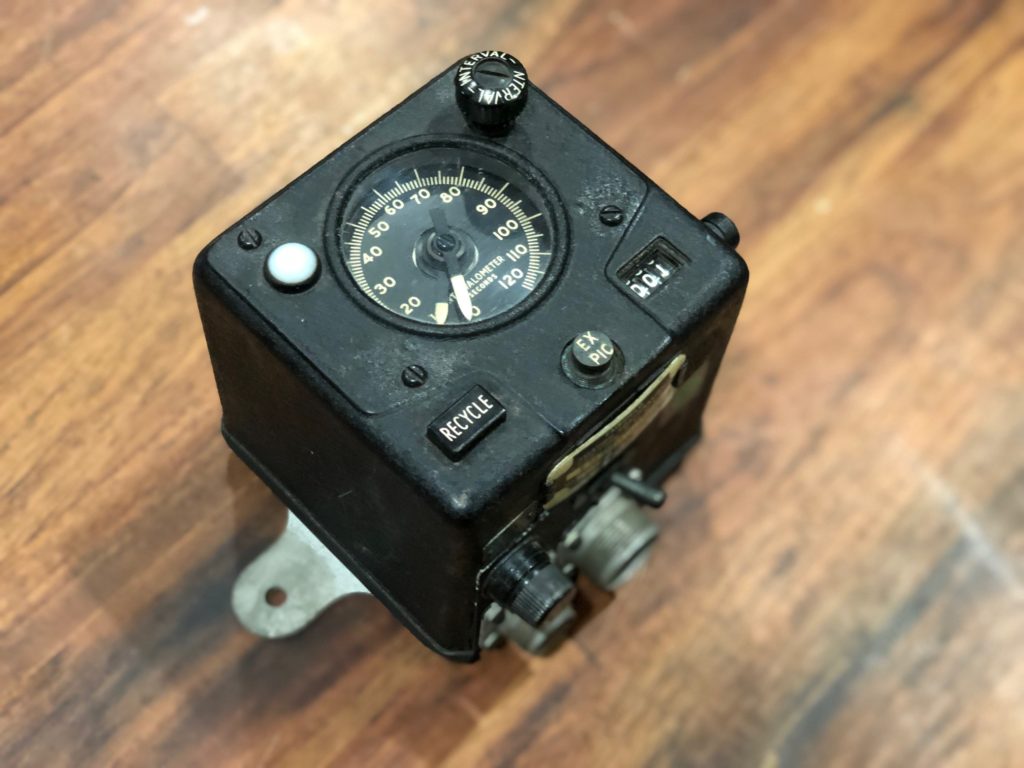
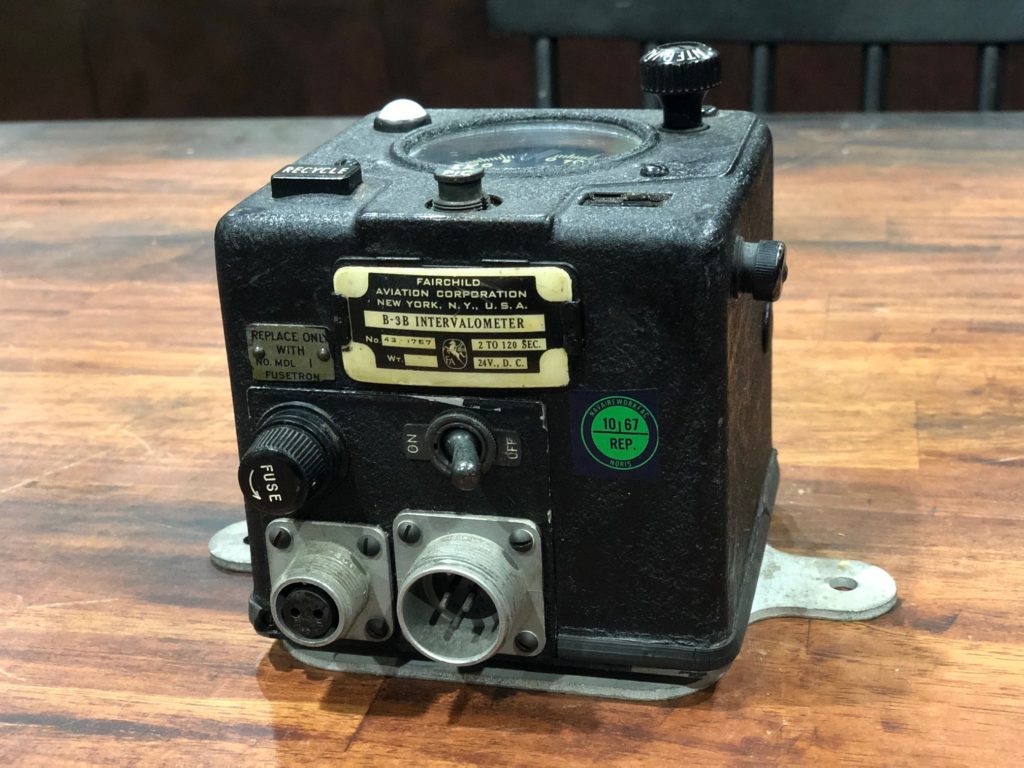
The newly-arrived Type B-3B Camera Intervalometer.
Photo taken 3 March 2022.
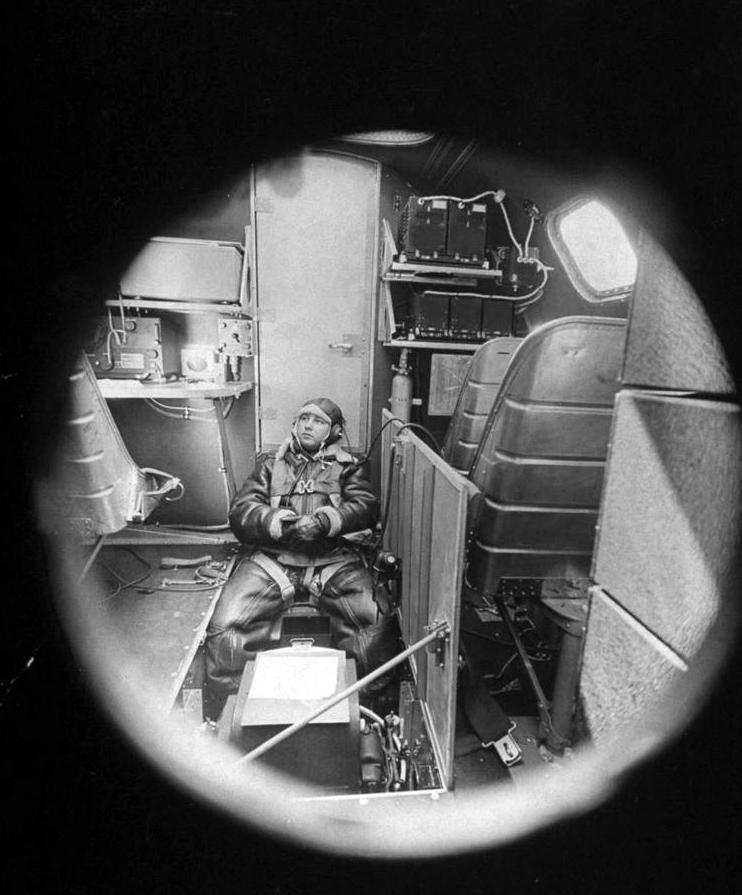
A heavily censored Life magazine photo showing the camera bay in use on an E-model B-17.
Note the extra bucket seats – these were usually removed before going into combat.
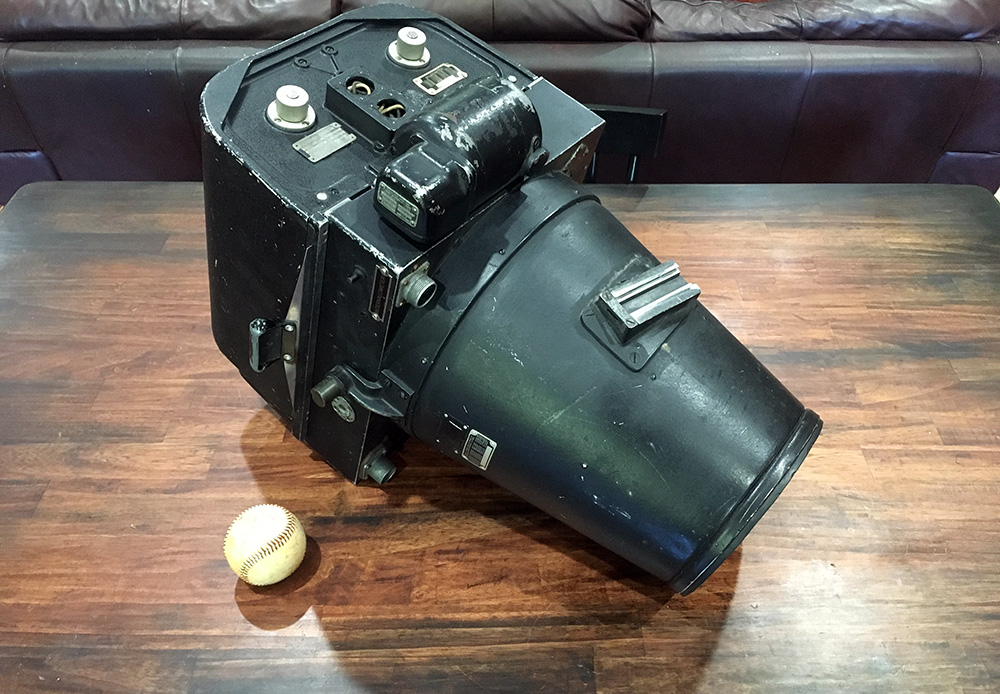
Max’s donated Type K-17 strike camera sitting on my dining table.
The baseball is for size comparison.
Photo taken 18 October 2021.
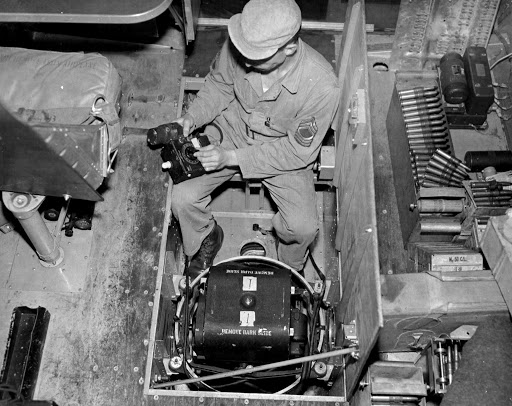
An airman installs a Type K-17 strike camera aboard a rather junky early Boeing B-17F. The intervalometer he is testing is a Type B-2, the B-3B’s predecessor. The mount is a Type A-11.
Note the cockpit fuse panel leaning against the wall in the back.
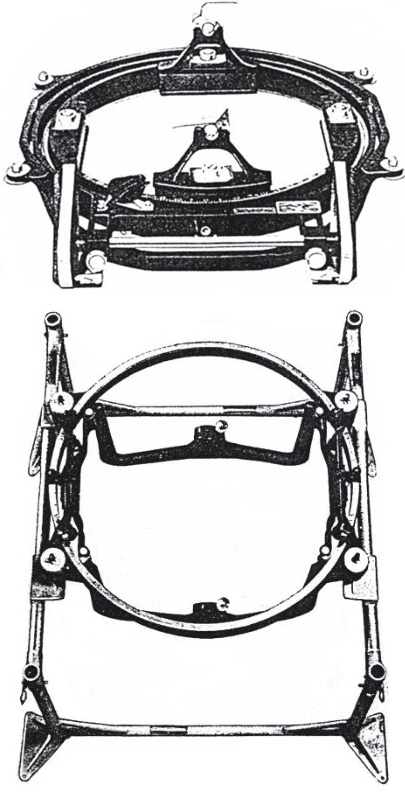
The Type K-17 camera was designed to be held by either the Type A-11 mount (above) or Type A-8 mount (below).
If you can help locate either one of these for Lucky Thirteen, please let us know!

A manual illustration of a Type A-2 Vertical View Finder.

A strike photo taken on 31 August 1943 over the Amiens-Glisy airfield.
This was the fifth combat mission flown by Lucky Thirteen.
Today I wanted to share a pair of exciting donations.
First is a piece unique to the Boeing B-17 – the sheath for the bomber’s crash axe.
You might recall that around this time, two years back, we acquired a Gemtor 42D8331 crash axe. This axe was kept in the cockpit and was used to hack away obstructions in the event of an emergency. A superb design, this particular axe remains in production to this day. While modern Gemtor crash axes are sheathed in leather, wartime units were issued without sheathes. For stowage purposes, Boeing designed a canvas sheath for the B-17’s crash axe.
While it may be a small thing, we at Hangar Thirteen love tiny details. So, we reached out to Beaver Mountain Works in Maple Ridge, British Columbia. Owner Mark Lewis is a US Army veteran and an expert in leather work who specializes in holsters and sheathes. When we asked if he would be willing to help with the crash axe, Mark was thrilled to participate! Wartime OD cotton duck is strong, smelly, and inflexible, but Mark’s expertise with leather meant that he had no trouble working with this material.
Mark was incredibly patient and thorough, willing to work without the axe in-hand and even sending a practice sheath to ensure proper fit. At no point did we run into any problems – the fit is absolutely perfect. We sent Mark some wartime OD canvas (the same canvas Megan used to make the bumper pads on the tail gun ammunition boxes) and he went to work. The sheath arrived yesterday and we are extremely happy. It is always exciting when pieces are completed that have not been seen since the war!
The other recent donation is a TU-8-B Tuning Unit, donated by Sean Barton of Sullivan, Missouri.
The TU-8 was one of seven tuning units stowed aboard the B-17 for the SCR-287 Liaison Radio. The SCR-287 was the largest of the B-17’s radio systems, being primarily composed of the BC-348 Receiver on the Radio Operator’s desk, and the BC-376 Transmitter on the shelf behind. Five tuning units were stacked on the opposite wall, with another kept under the shelf and yet another plugged into the Transmitter. Each unit covered a different frequency range, the idea being that you would plug the appropriate unit into the transmitter when needed.
Thanks to Charlie Liberto – Hangar Thirteen’s radio honcho – we have been fortunate to locate five of the seven tuning units. Today, some are easier to locate than others because some function on restricted frequencies. Sean noticed that we were missing the TU-8 on the Parts Drive page of our website and wanted to help out. This TU-8 is a beautiful example and we are extremely thankful for his donation.
As the war dragged on, the USAAF eventually cut down on the number of tuning units carried by heavy bombers. However, since we do not know exactly when this took place, or exactly which units were retained and which were removed, we have elected to outfit Lucky Thirteen with the standard, full complement.
It is our goal at Hangar Thirteen to restore each and every radio system to full operation. To that end we have made INCREDIBLE progress. Since it will be some time before the airplane is ready for installation (at which time we will need to invest in period-correct cloth wire), it is our intention to display these units in the hangar while work continues. The only pieces we lack for the radios are:
– TU-6-B Tuning Unit (SCR-287 Liaison System)
– MC-163 Fairlead Clamp (RL-42 Reel Antenna)
– BG-109-A Accessory Bag (SCR-578-A Gibson Girl Emergency Radio)
– 14-2345 Whip Antenna (SCR-269 Radio Compass)
– Brass Tuning Cable (Gyro Fluxgate Compass)
– 2x FT-115 Sway Mounts (SCR-287 Liaison System)
In regard to the FT-115s, we are currently using FT-167s, which are visually identical but with different weight ratings. Likewise, while we have TWO BG-110 Gibson Girl transmitter bags, neither still have their parachutes attached. Charlie has also expressed a desire to locate a spare PE-73 Dynamotor for the BC-375.
Outside these tiny few needs, we are EXTREMELY close to completing the radio parts drive for Lucky Thirteen.
Special thanks to Mark Lewis and Sean Barton for these amazing contributions!
Likewise, a special thanks to Patrick Mihalek of Warbirds Of Glory Museum for providing us with the appropriate reference material to replicate the missing T-bar which mounts the IFF controls above the radio operator’s desk. This was the final major component missing for our IFF system.
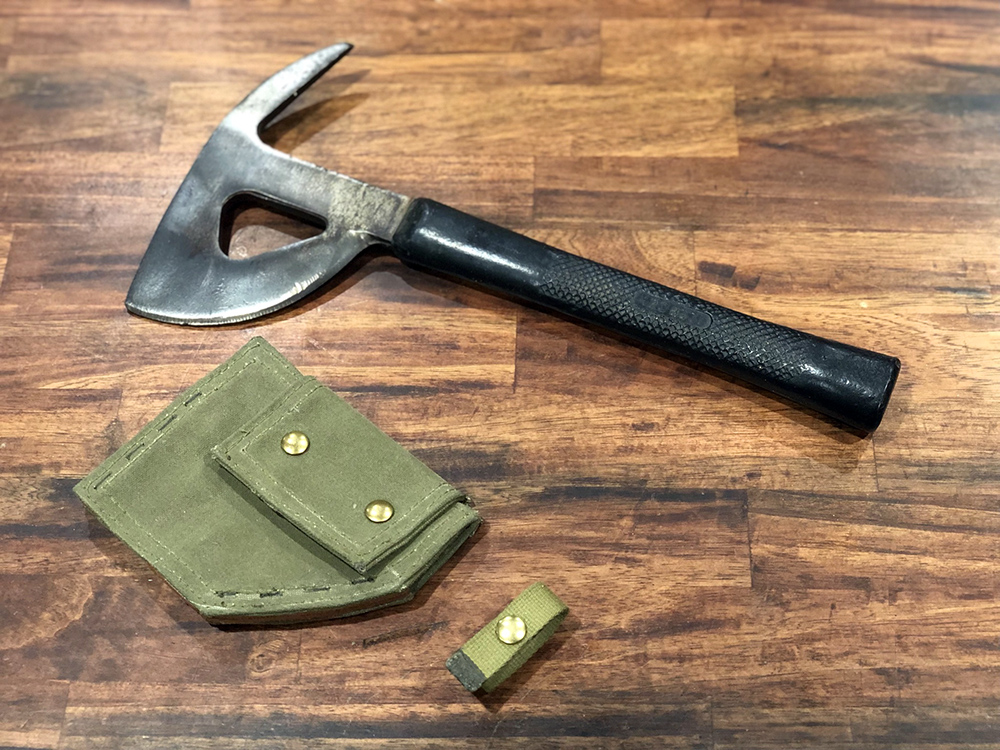
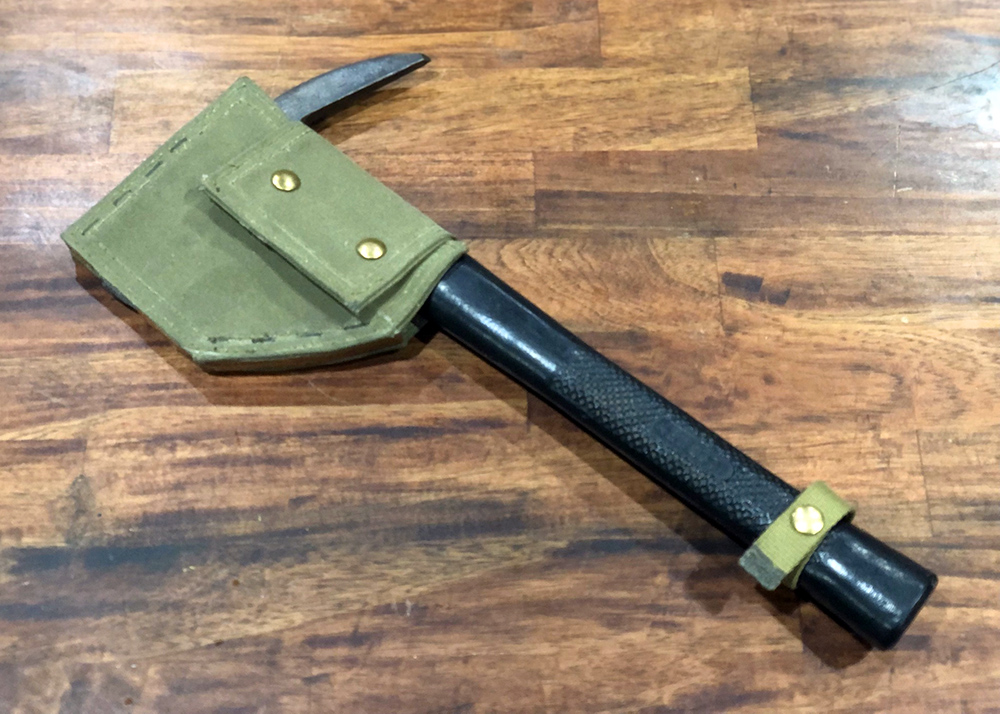
The newly-arrived sheath and stowage strap for the crash axe, made by Beaver Mountain Works in Maple Ridge, British Columbia.
The pencil marks indicate where the staples go to attach the sheath to its backing plate. Mark was kind enough to provide us with the correct staples, with spares.
Photo taken 9 March 2022.
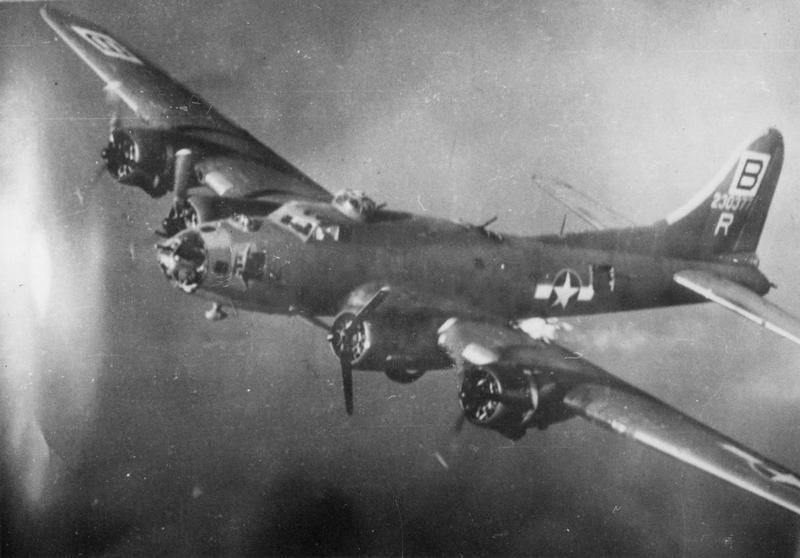
Roger the Lodger II (42-30377, 95BG) burns over the English Channel on 9 October 1943.
The speed at which a fire can spread on an aircraft is shocking. Seven of the ten-man crew aboard Roger the Lodger II managed to escape but not before two of their parachutes caught fire. The three who didn’t get out were those in the cockpit.
In the end, there were no survivors from Roger the Lodger II.
Roger the Lodger II and Lucky Thirteen share a common background. When first formed in the US, both crews were photographed in front of the same airplane.

A drawing I made illustrating the equipment stowed on the pilots’ seats.
The crash axe is stowed on the back of the co-pilot’s seat, beside the paper cup dispenser.
The paper cup dispenser, along with the chemical toilet, has proven to be one of the more difficult oddball pieces for us. Unless an original is forthcoming, we hope that we can recreate this piece with proper references.

The crash axe, complete with its wartime-accurate sheath, is displayed on the backplate board that it will later be permanently affixed.
Photo taken 9 March 2022.
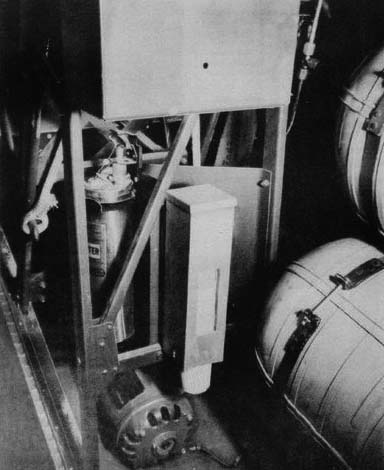
A manual illustration from the B-17’s manual shows the paper cup dispenser.
This B-17 is a bit older than Lucky Thirteen as the crash axe is stowed elsewhere, a Carbon Tet fire extinguisher instead being kept under the co-pilot seat.

Reference photo taken from Boeing B-29A 44-61975 (painted as Jack’s Hack) by Nick Hurley of the New England Air Museum in Windsor Locks, Connecticut.
Note the paper cup dispenser to the left of the signal lamps.
Photo taken 12 October 2021.
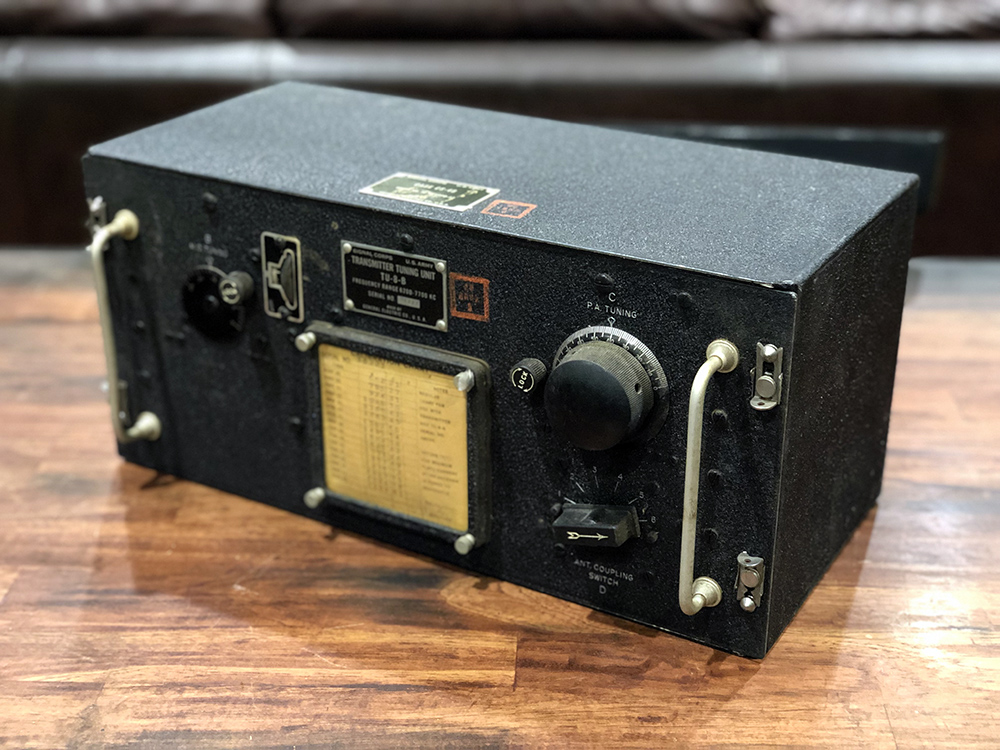
The newly arrived TU-8 Tuning Unit donated by Sean Barton.
This unit covers the 6200-7700 KC range.
Photo taken 4 March 2022.
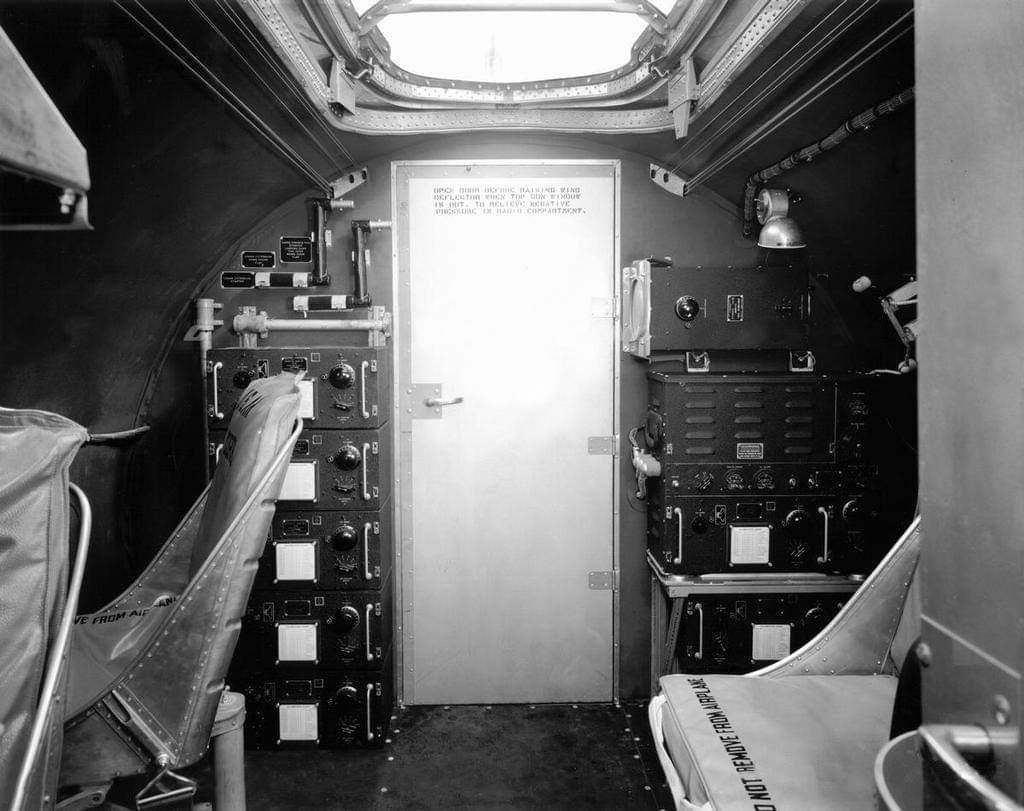
Bulkhead 6 aboard a Boeing B-17. This particular photo was taken on an E-model in the United States, as evidenced by the two passenger chairs – which were usually removed.
Note the stack of five tuning units on the left wall and the two on the right wall. Altogether, they covered frequencies ranging from 1500 – 12,500 KC, as well as 200 – 500 KC.
This might be a good time to talk about visitors.
We love visitors! But we are not a public facility – at least, not yet. It is important to remember a few things. First, our project is located in Hangar 3 at the Asheville Regional Airport in Fletcher, North Carolina. Because we are on airport grounds, visitors must be accompanied at all times by an airport ID holder. It is an annoying security rule, but it makes sense when you realize that you have to step onto the tarmac to reach our hangar. We have looked into installing a door that opens to the outside, but doing so requires paying very expensive security deposits for cameras to monitor visitors coming in and out the hangar. So, it is easier to just call ahead and schedule a visit with us.
This leads to the second point. We are still a very small group. Most of Hangar Thirteen’s volunteers work from home, keeping in touch with one another via phone/e-mail/messages etc. While we would love to have more volunteers – both at home and at the hangar – so far Ray is the only one consistently at the hangar. Because of this, I try to always be there whenever someone visits, if only so Ray won’t have to stop working. However, it is a three-hour drive for me to come to the hangar, so some advanced warning is required. Do keep in mind that, because so many of us work from home, there are many pieces that you will not see at the hangar. Ray and I both work on the B-17 full-time, so weekdays are always better than weekends.
So, who were our latest visitors?
On Sunday we got to meet Mitch Bertrang and Maureen Maly of the CAF’s Minnesota Wing. Mitch and I met online while he has been restoring the radio systems on North American B-25J 44-29869 (painted as Miss Mitchell, 43-27493, 310BG). Mitch and Maureen were driving from Florida to Minnesota and took an alternative route so they could stop by and visit. Because it was the weekend, we were not able to get to the hangar, but we managed to meet at Joe McKowen’s place, where Mitch was able to acquire some parts to aid in the completion of his project. They were kind enough to take Megan and me out to lunch – thank you so much!
The very next day we had another visitor – Stijn Claus and Katrien Vandevelde, who were visiting from Belgium. It turned out that Stijn and Katrien had planned a complex trip here in the States, specifically intending to visit the National Museum of the US Air Force and Hangar Thirteen. Stijn is the founder of the B-17 Flying Fortress Parts Project and has been our friend for a long time, so it was great to finally meet face-to-face. We spent over six hours walking around our little hangar chatting. Stijn showed me some pics of his work and I have to say, there is a lot that he has not posted online. He is EXTREMELY talented – too bad he couldn’t just say here with us! We are supporting each other’s work and looking forward to the future.
Words cannot convey the honor we feel in having visitors come all that way to see us. Thanks guys. If you have not already, be sure to follow Mitch’s work at the Commemorative Air Force Minnesota Wing page and Stijn’s work at the B-17 Flying Fortress Parts Project. The work these guys are doing is nothing short of amazing.
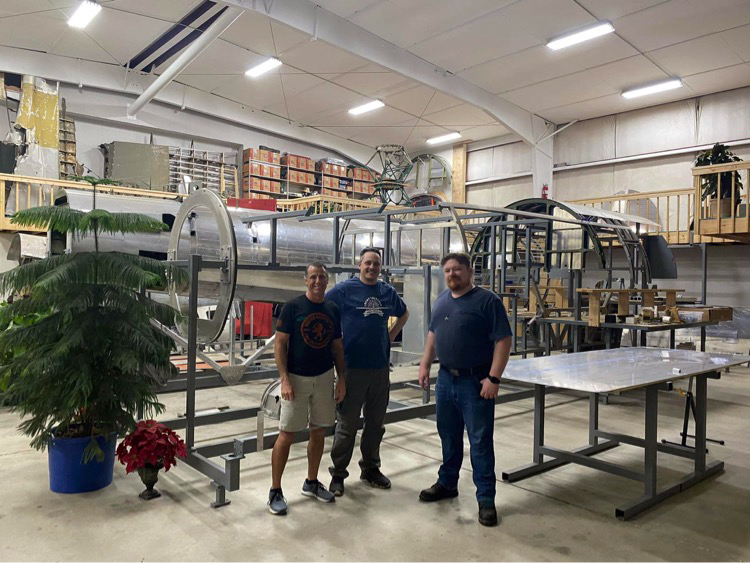
Stijn Claus poses with Ray and me beside the Lucky Thirteen.
Photo taken 7 March 2022.

Stijn looks over the hangar from our storage area.
On the table is Bulkhead 5 from Lucky Thirteen, disassembled so that its framing can be dipped in zinc chromate – a common wartime practice by Douglas Aircraft. Once ready, the ALCLAD-stamped skins will be reapplied and the assembly permanently riveted.
Photo taken 7 March 2022.
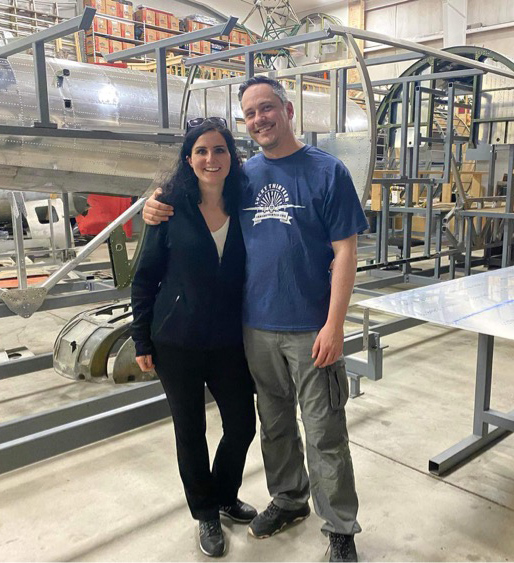
Stijn Claus and Katrien Vandevelde.
Stijn and Katrien were super nice and Ray and I had an absolute blast hanging out with them.
Photo taken 7 March 2022.
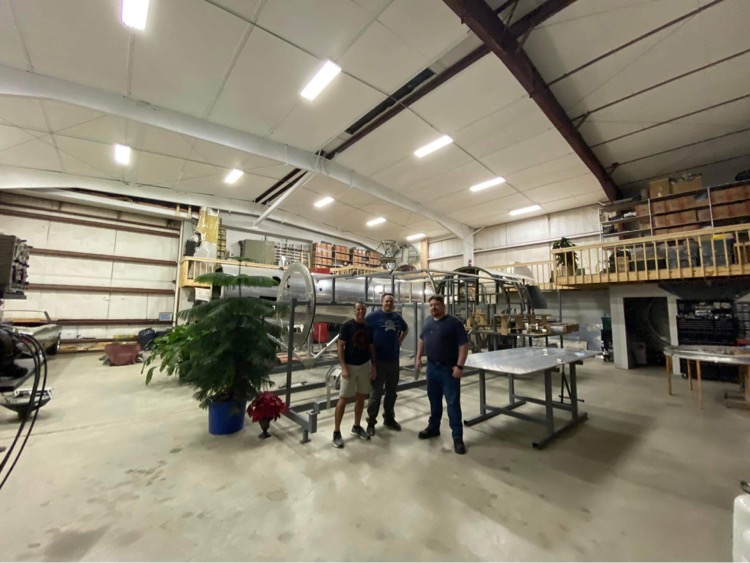
Stijn Claus poses with Ray and me beside the Lucky Thirteen.
This picture was so cool that I just had to share it. Makes the hangar look roomier than it actually is!
Photo taken 7 March 2022.

Joe McKowen’s place is in Gaffney, South Carolina and, while I love my home state, Gaffney is not a particularly handsome area.
It is best known for its watertower, which you see here.
While Georgia is often called “the Peach State,” South Carolina actually produces three times as many peaches as Georgia. Despite this watertower being in Gaffney (which is the near the North Carolina border), South Carolina’s peach orchards are mostly in the lower midlands – where I’m from.
Photo taken 6 March 2022.
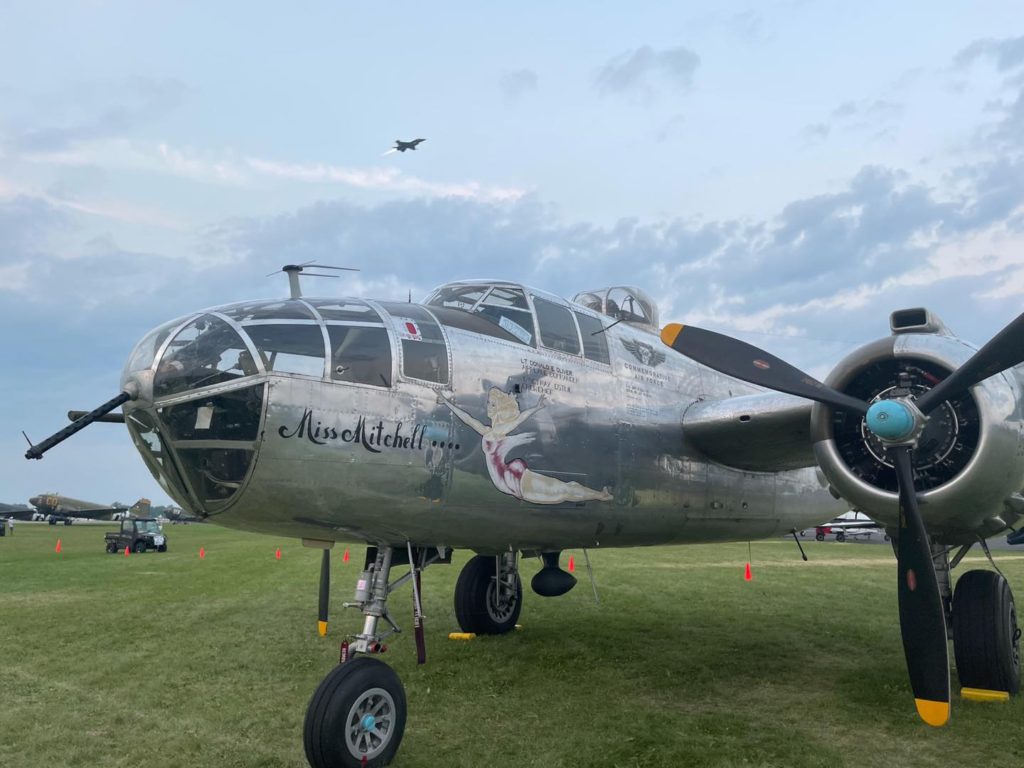
I did not get any pics with Mitch Bertrang and Maureen Maly, so I thought I would share some pics of his work.
Here is the North American B-25J 44-29869 of the CAF’s Minnesota Wing, kept in the colors of Miss Mitchell (43-27493, 310BG). The noseart is particularly special – it was painted by Ray Kowalik, the man who painted the original Miss Mitchell during the war.
Note the General Dynamics F-16 in the background. The B-25 and F-16 share South Carolina as a common home. During the war, medium bomber training was centered in Columbia, SC, with numerous satellite fields being scattered around the state. One of these satellites is Shaw AFB, which is today the home of the 9AF and 15AFs and one of the largest F-16 bases in the US.
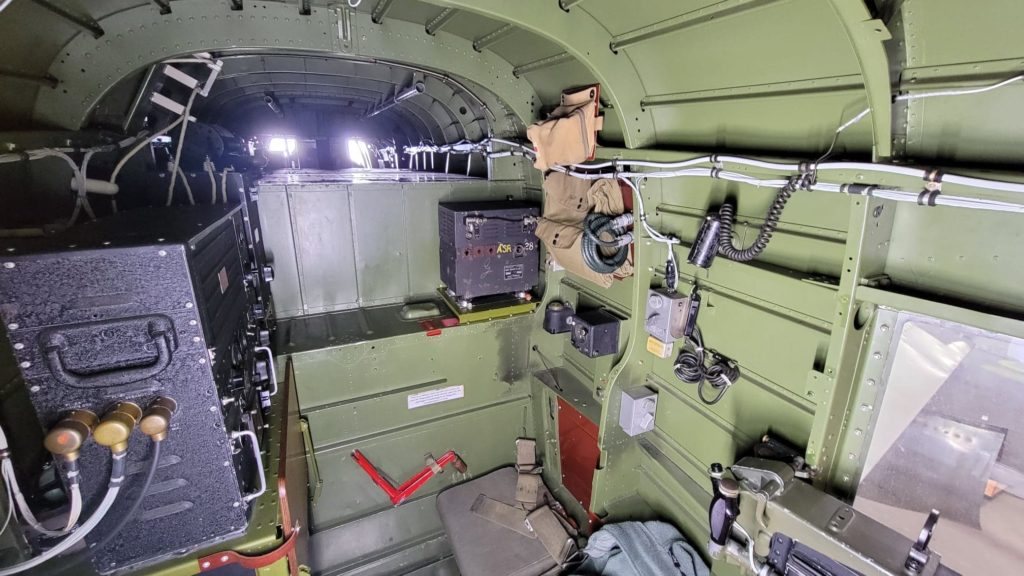
An older photo showing Mitch’s work on Miss Mitchell.
Here he has installed the BC-966 Transponder to the SCR-595 IFF system – an exceptionally rare piece for WWII aircraft. When Mitch installed the antenna for this system, he was able to uncover its original mounting holes – too cool! Mitch has made even more progress in this area since the photo was taken. He is currently working on the SCR-522 VHF system – a system largely unique to Allied aircraft in the European and Mediterranean theaters of operation.
Photo taken 8 April 2021.
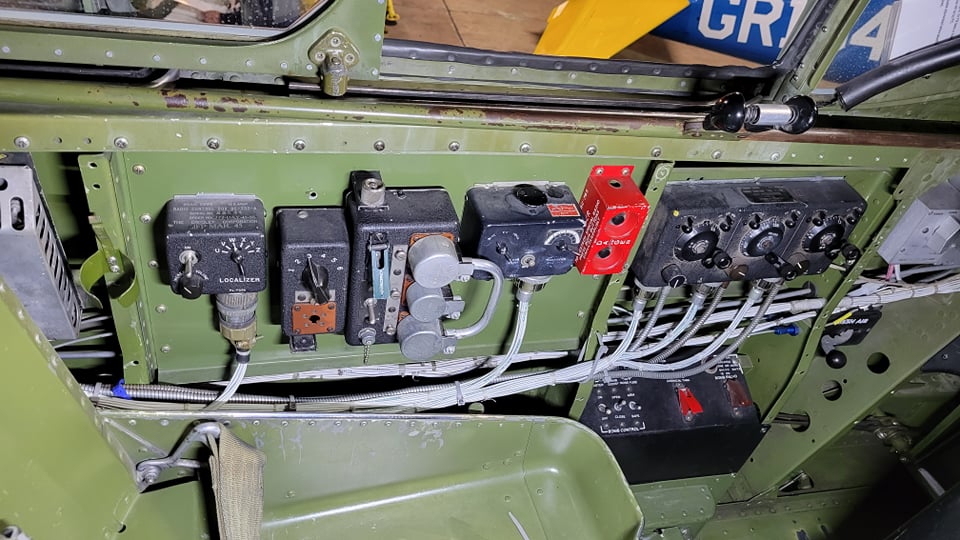
The RC-255 (BC-958/965) control box for the SCR-595 IFF system is installed in the cockpit of Miss Mitchell. It is the two-piece box with the three gray plugged cables.
The red box nearby is a self-destruct controller, which detonates an explosive charge in the IFF transponder. Designed to prevent enemy forces from acquiring a functional US transponder and obtaining Allied frequencies, there is a second self-destruct switch by the radio operator which uses an inertia spring to set off the charge if the aircraft is shot down and the crew incapacitated.
Photo taken 11 November 2021.
A couple small updates.
First up is an AN5822-1 Air Filter, made by Skinner Purifiers of Detroit, Michigan. This piece mounted to the Instrument Panel Housing and filtered the air used by the vacuum-operated instruments. There were two major variants of this filter, which looked nothing alike, but we had come across an opportunity to acquire a NOS example that we did not want to lose. Karl Hauffe was able to locate a wartime photo that clearly showed said variant in usage, so we were able to get it safe in the knowledge that it is accurate to our project. Thanks Karl!
Similarly, our friend Dom Serong was kind enough to provide references for us regarding our autopilot amplifier box. These are extremely rare and while our piece is in superb condition, it is missing its side-cover and top plate – no doubt for display purposes. Dom provided us with the information necessary to recreate these pieces, as well as reference photographs for the placards originally located there. Thanks to his help, we have managed to recreate said placards.
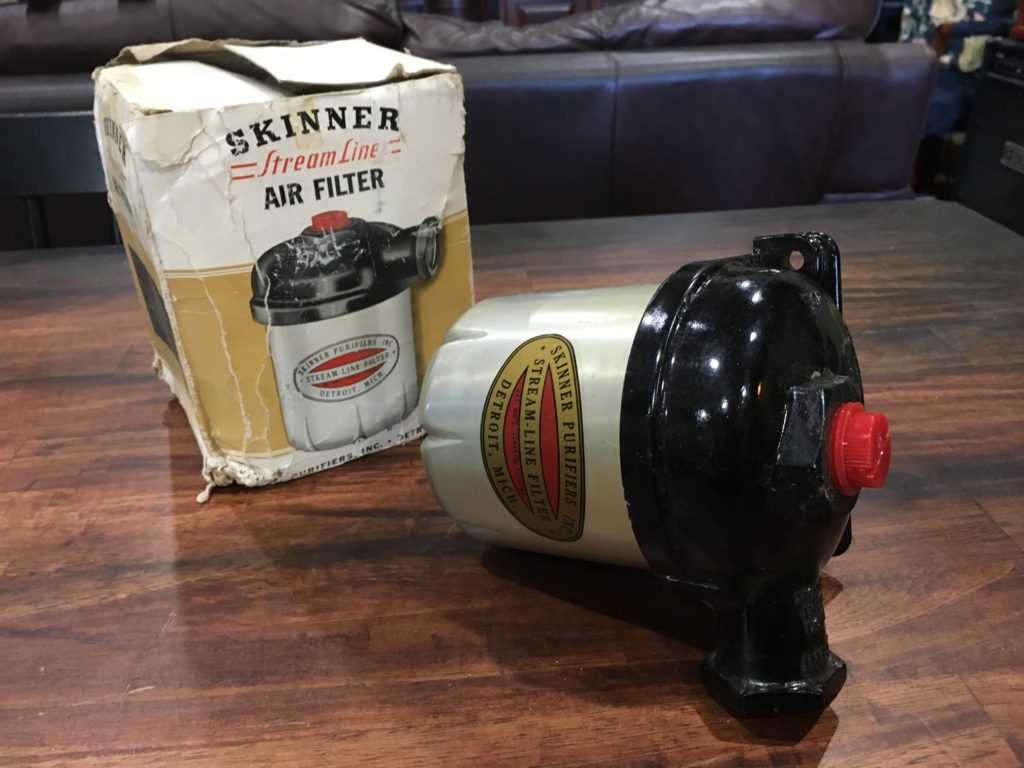
The newly arrived NOS Skinner AN5822-1 Air Filter.
Photo taken 10 February 2022.
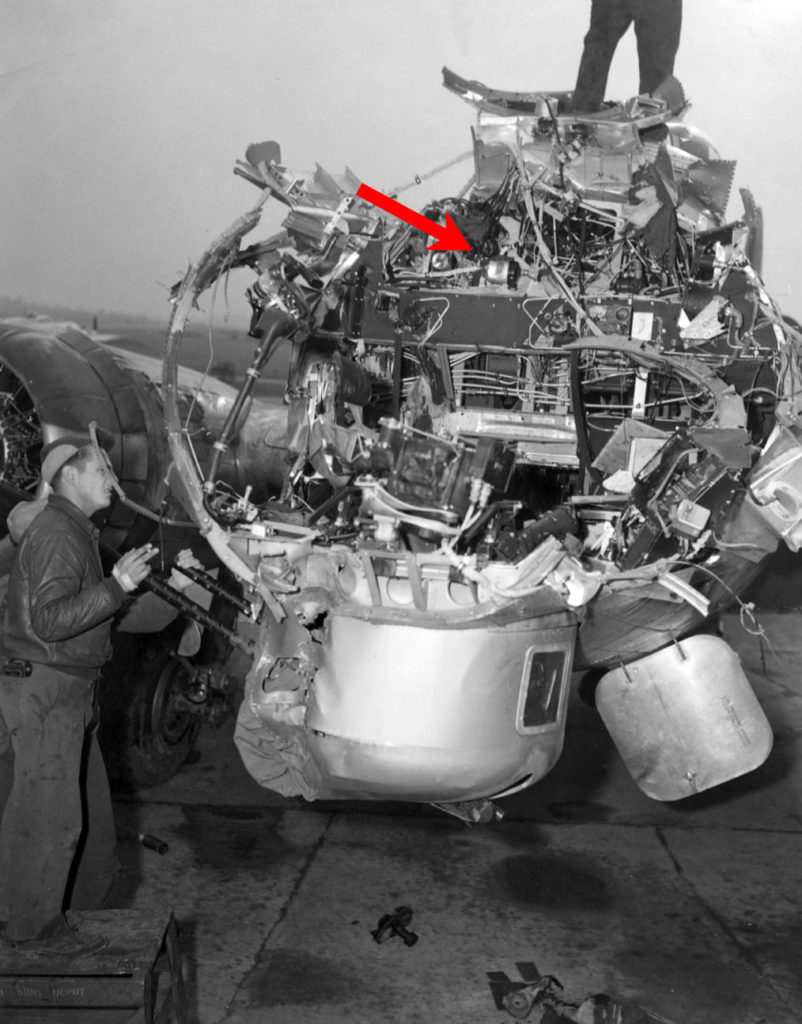
A direct hit from 88 mm AAA fire nearly downed 2 Sad (43-38172, 398BG) on 15 October 1944 over Cologne, Germany. Togglier SSGT George Abbott was killed instantly but navigator 1LT Ray LeDoux survived, managing to crawl back up into the cockpit.
This photo confirmed the usage of the Skinner-built AN5822-1 Air Filter on the B-17. The filter is highlighted in the photo.
Note the Type A-12 Oxygen Regulators on the Station 3 bulkhead. They do not look alike because they were made by different companies. The one on the left was made by ARO and the one on the right by Pioneer.

Looking a little rough for wear, an AN5822-1 made by Purolater of Newark, New Jersey. This piece was found in the McKowen Collection. While radically different in appearance from the Skinner type, they are technically the same filter.
Photo taken 17 April 2021.
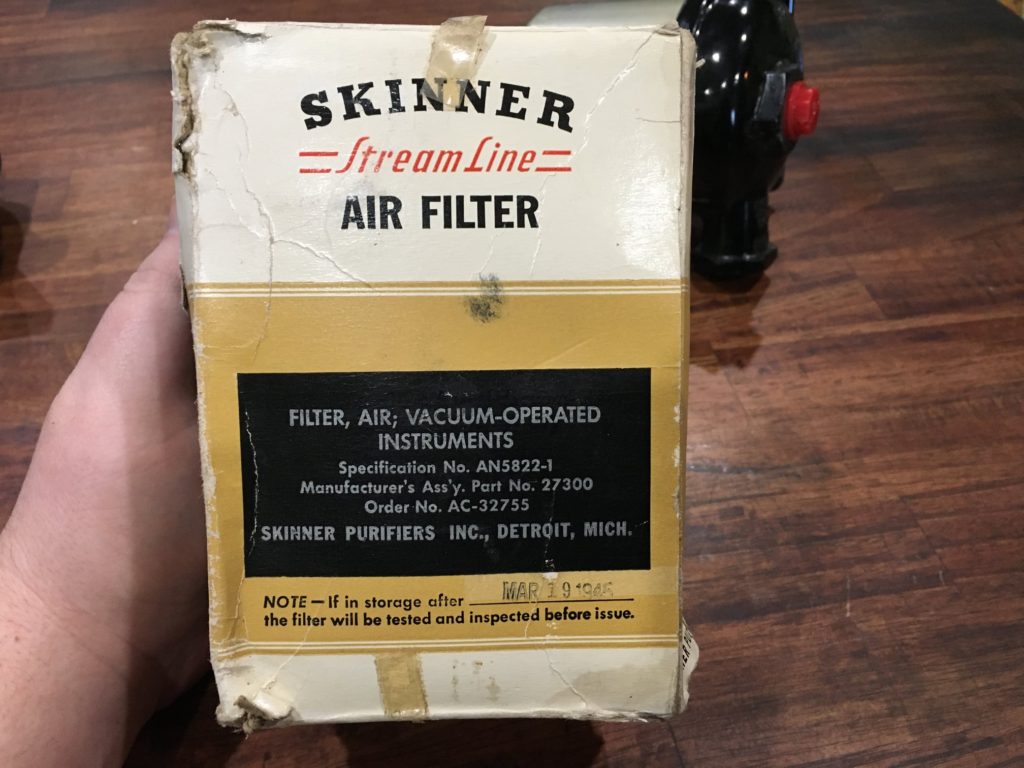
The newly arrived NOS Skinner AN5822-1 Air Filter.
While the filter doesn’t have a production date, it does call for an inspection after 19 March 1945.
Photo taken 10 February 2022.
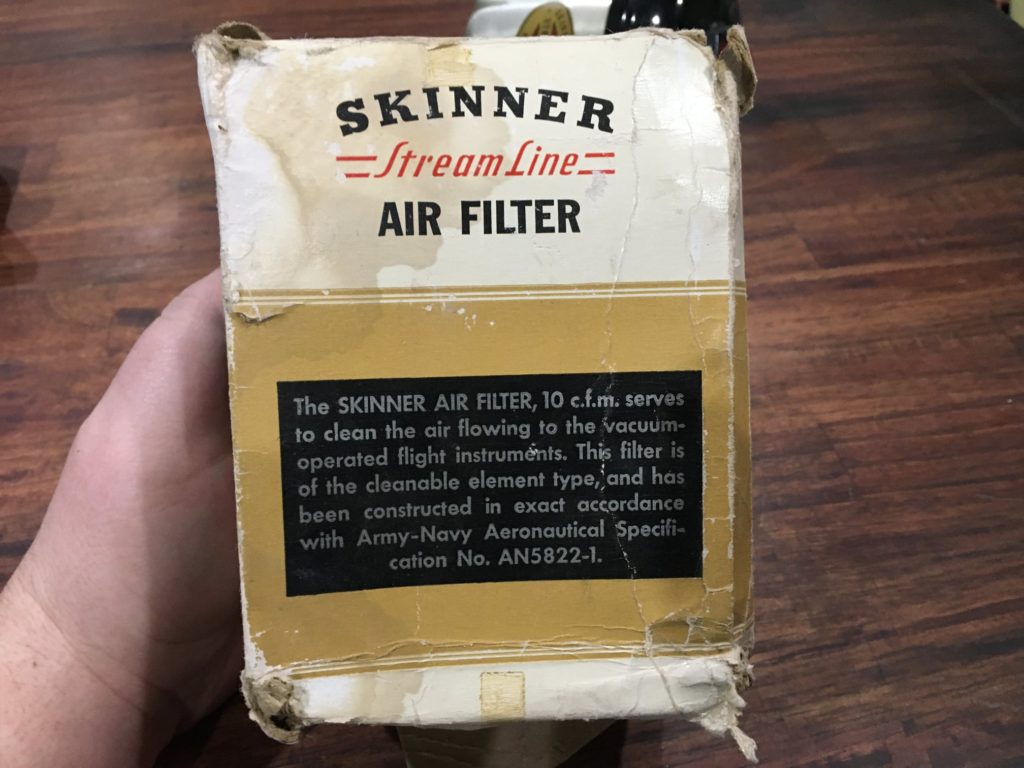
The newly arrived NOS Skinner AN5822-1 Air Filter.
Photo taken 10 February 2022.
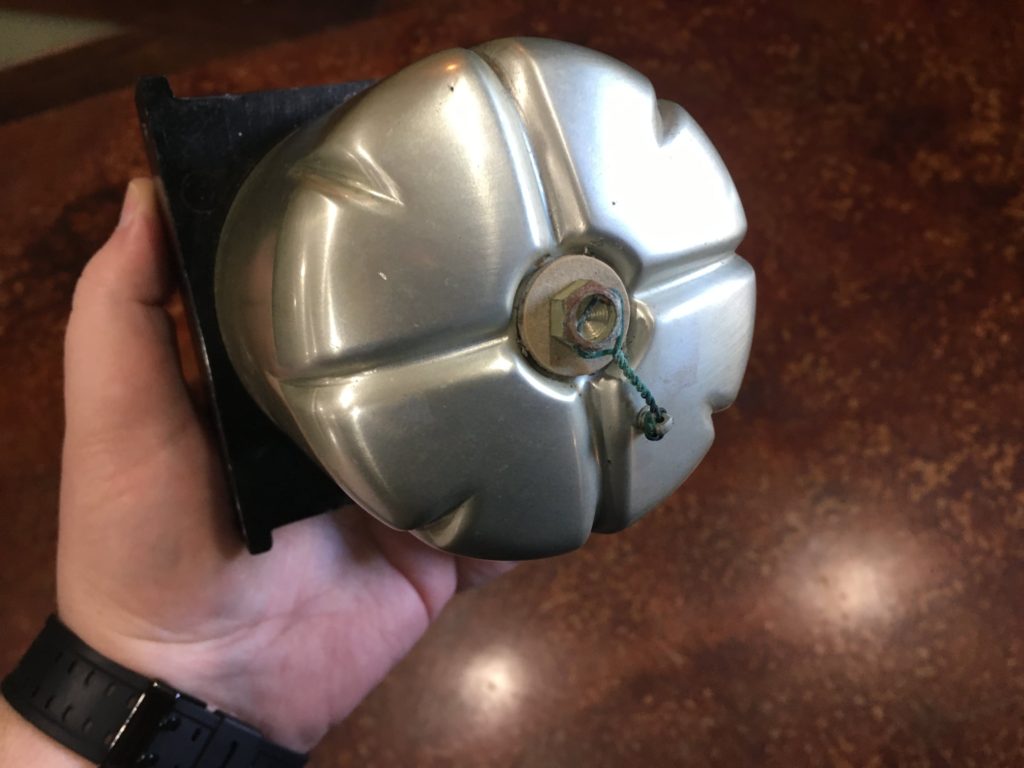
Often pieces on the aircraft use lengths of brass wire to hold screws in place – an easy way to cut your hand if not careful!
This wire was carefully removed (and saved) to check the condition of the filter inside.
Photo taken 10 February 2022.

The filter is removed from the NOS Skinner AN5822-1 Air Filter.
Perfect.
Photo taken 10 February 2022.
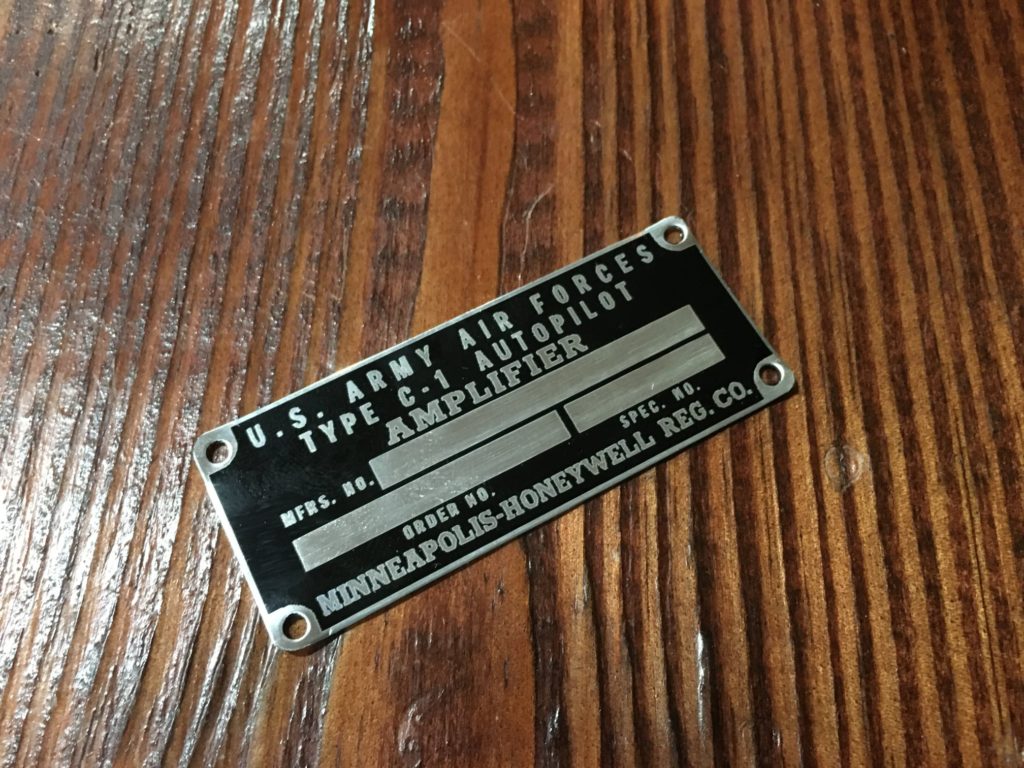
The recreated dataplate for the Amplifier box from the Honeywell Type C-1 Autopilot System.
Photo taken 14 February 2022.
It was an interesting Valentine’s Day…
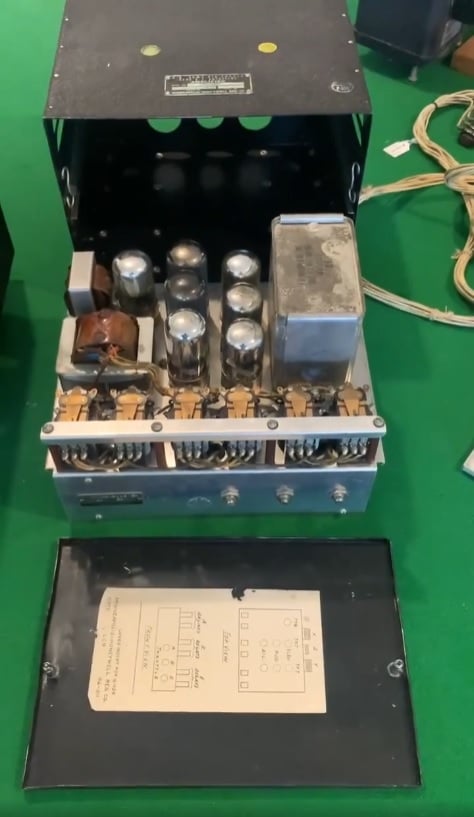
A screenshot taken from a video sent to us by Dom describing the missing side cover from our autopilot amplifier.
Measurements and closeup shots of the enclosed diagram and dataplate were used as references.
Screenshot taken 22 November 2021.
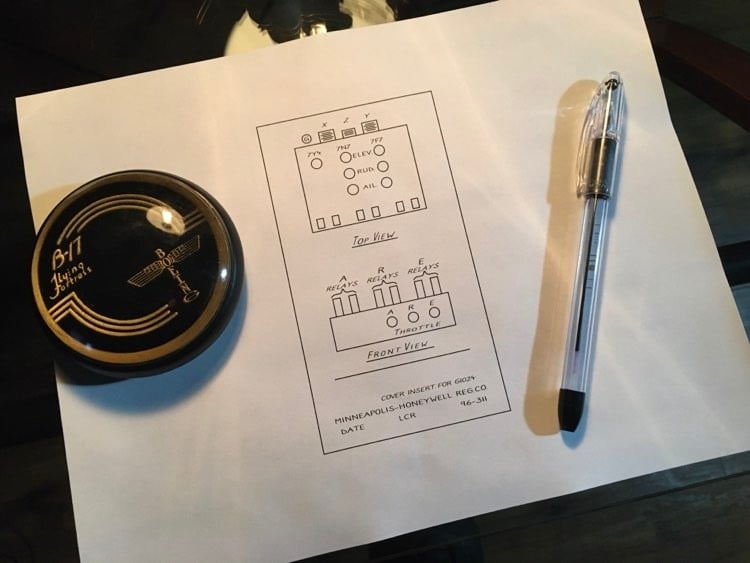
The diagram that was originally glued to the autopilot amplifier’s side cover is recreated.
Photo taken 22 November 2021.
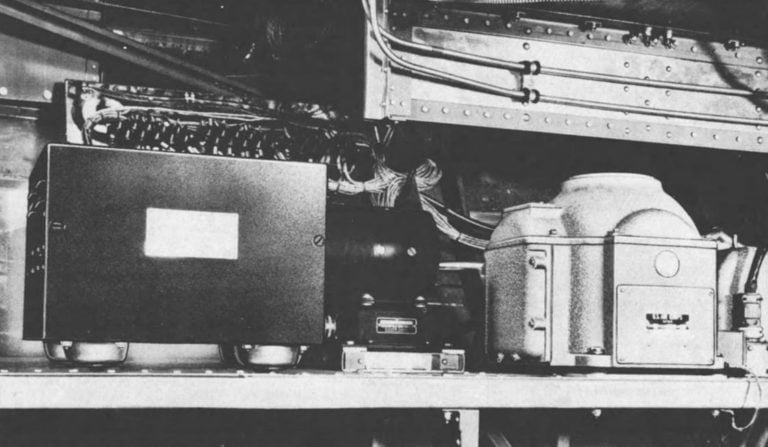
A manual illustration showing (from left to right) the autopilot amplifier, inverter, and gyroscope. These are located just under the cockpit floor.
The inverter in this illustration is an Eicor type.
The junction box is visible behind this equipment, with its cover removed. This piece will likely have to be recreated from scratch.
Today’s update is about our good friend Anton Hermans in Thailand.
Anton is the one who fabricated our center console panel, which arrived here in July 2021. His work was meticulous, so much so that we dared ask if he would be willing to fabricate the console assembly which fit underneath.
It arrived here yesterday!
Contrary to what is seen on many home panel displays, the center console on the Boeing B-17 is actually quite complex. Essentially, a welded box compartmentalizes the two dual magneto switches to one side, while an upper T-bar provides support for the cumbersome hydraulic cowl flap panel on the bottom. A large brace assembly underneath serves to mount the console to the forward side of the throttle column.
The blueprints for the center console assembly were extremely complex, with Anton and Bob Hachmann both creating CAD models for reference. Similarly, special thanks to Steve Salinas at Planes of Fame Air Museum for taking the time to photograph the assembly from Piccadilly Lilly II (44-83684).
The arrival of this console is a huge step forward and we cannot thank Anton enough for his hard work.
Before we can permanently mount the panel to this console assembly, there is still work to be done. The panel still needs the linkage for its mag switches and switchguards for the landing gear and main flaps, and the console will need the B-17’s distinctive Bronze Green cockpit paint applied. But the end is now in sight for this amazing cockpit piece for Lucky Thirteen.
As for the throttle column onto which this will eventually mount: Originally, we had hoped to acquire a F-model column (which are distinct from G-model types) in California, but a well-known collector was able to outpay us (a common issue). As such, Kevin Davenport and his class in Florida are CAD modeling the throttle column for future reference, though we are still keeping an eye out for an original.
Work continues on our other subprojects as well. Bob is continuing his work on the instrument panel housing and there are still a few gauges needed to fill out the panel itself. The gauges we have are currently mounted in a wooden mockup, as we will not cut the finished faceplates until the housing is ready for them. Our current fundraising focus remains the same, though we have specific items in mind for the near future if we can raise enough for them: a complete bombsight stabilizer (for the autopilot/bombsight) and hiring the services of a 3D scanning company in the Atlanta area (for the turrets).
Lastly, I would like to make clear our appreciation for Anton’s work. This center console assembly was no easy feat, and the finished product is absolutely superb. Since completing this piece, Anton has published a website showcasing his instrument panel works and services, which we heartily recommend everyone check out. We think you will be blown away by what you see! You can check it out here.
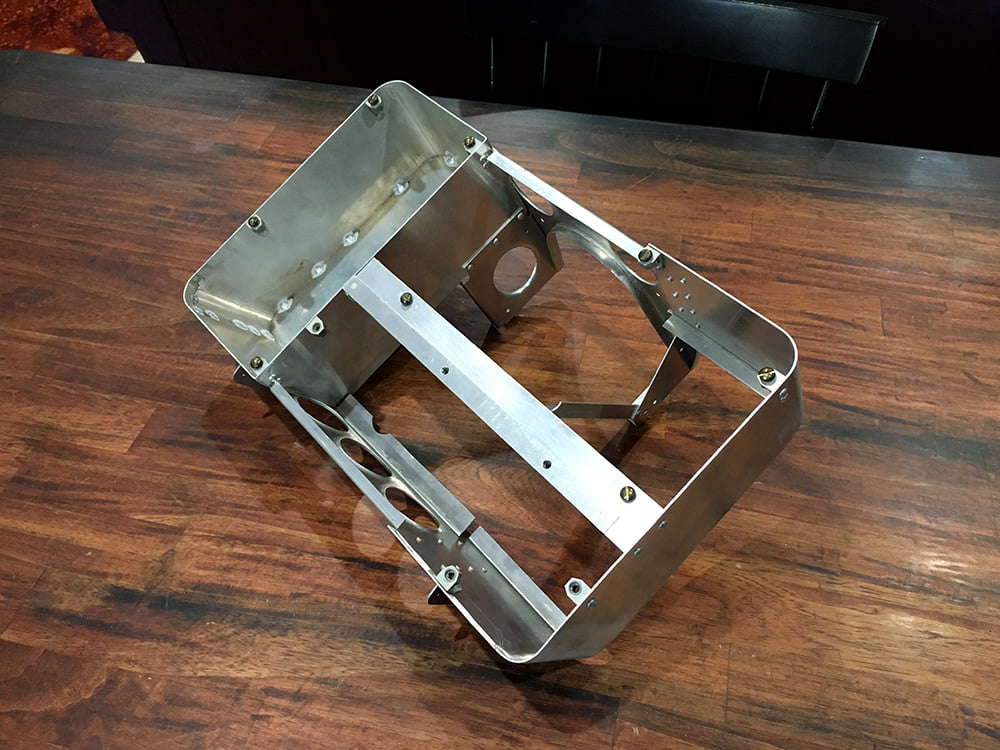
Anton’s newly-arrived center console assembly.
Photo taken 15 February 2022.
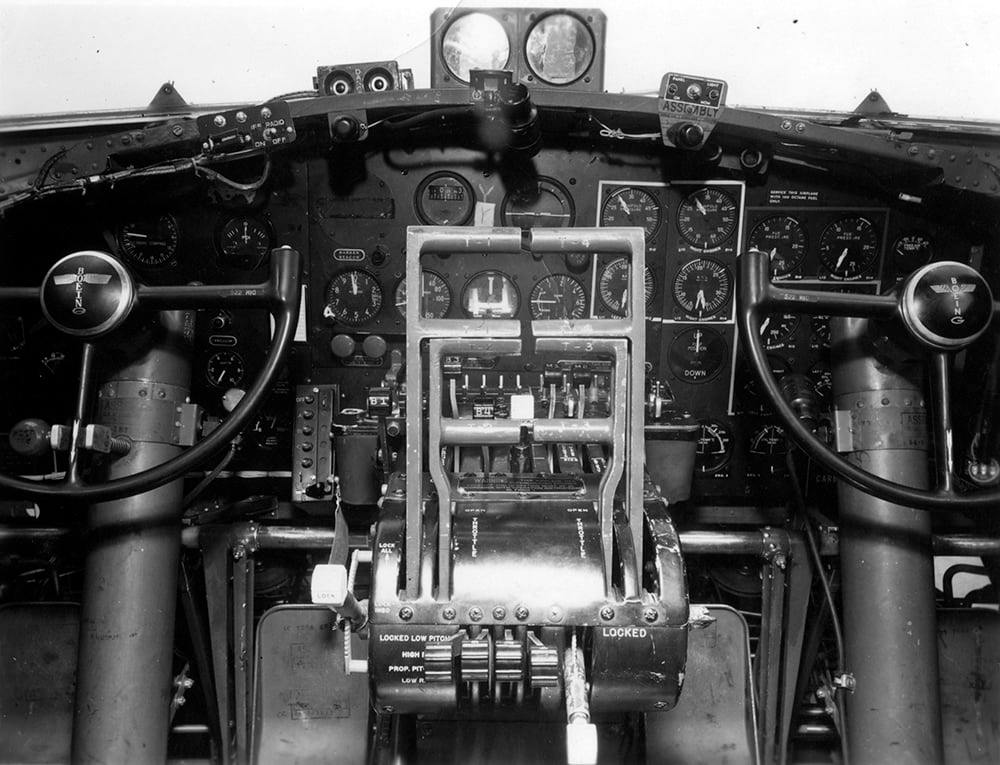
The center console assembly is visible here, just forward of the throttle column. From this angle, it looks like a simple box – but it is actually far more complex inside.
There are some items worthy of note in this wartime photograph.
This B-17 is an F-model somewhat older than Lucky Thirteen. The carburetor gauges are mounted above the panel rather than inside, for example.
Note the covered gauge hole on the upper left – this aircraft lacks any blind-landing equipment. A common find on F-model B-17s in the latter half of 1943.
Two aspects hearken variances often not seen. The turn and bank indicator is a type without hashmarks on either side of the needle, and the markings on this panel have been applied with the older style phenolic placards rather than decal transfers.

Anton’s newly-arrived center console assembly.
This is the side that butts up against the instrument panel.
Photo taken 15 February 2022.

Anton’s newly-arrived center console assembly.
Photo taken 15 February 2022.
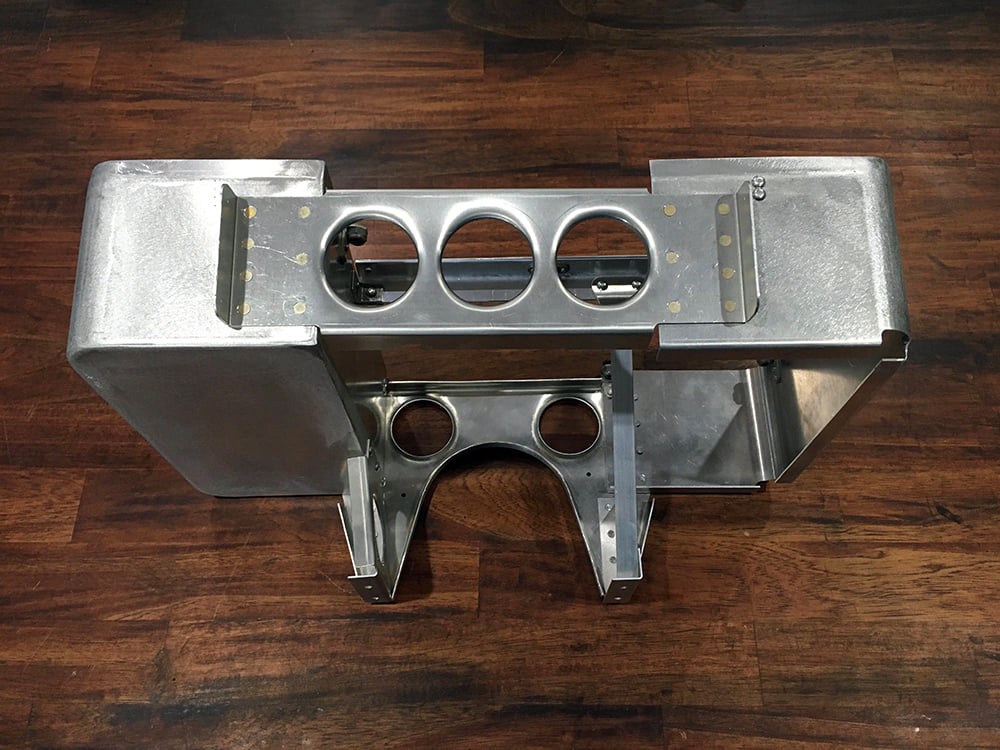
Anton’s newly-arrived center console assembly.
This is the side that butts up against the throttle column.
Photo taken 15 February 2022.
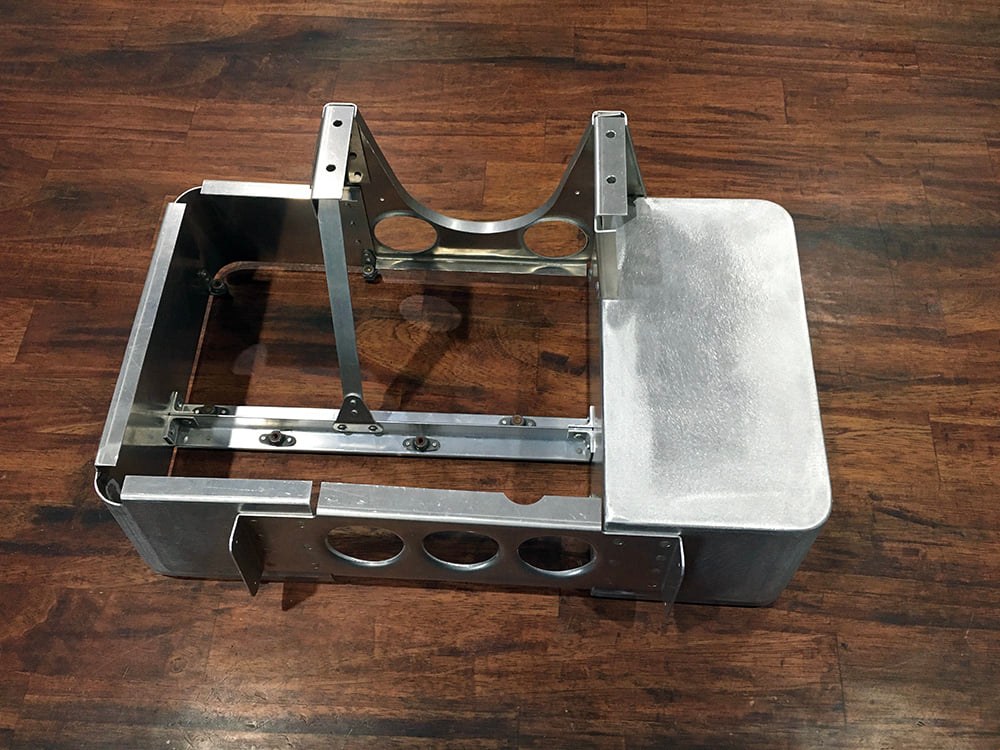
Anton’s newly-arrived center console assembly.
Photo taken 15 February 2022.
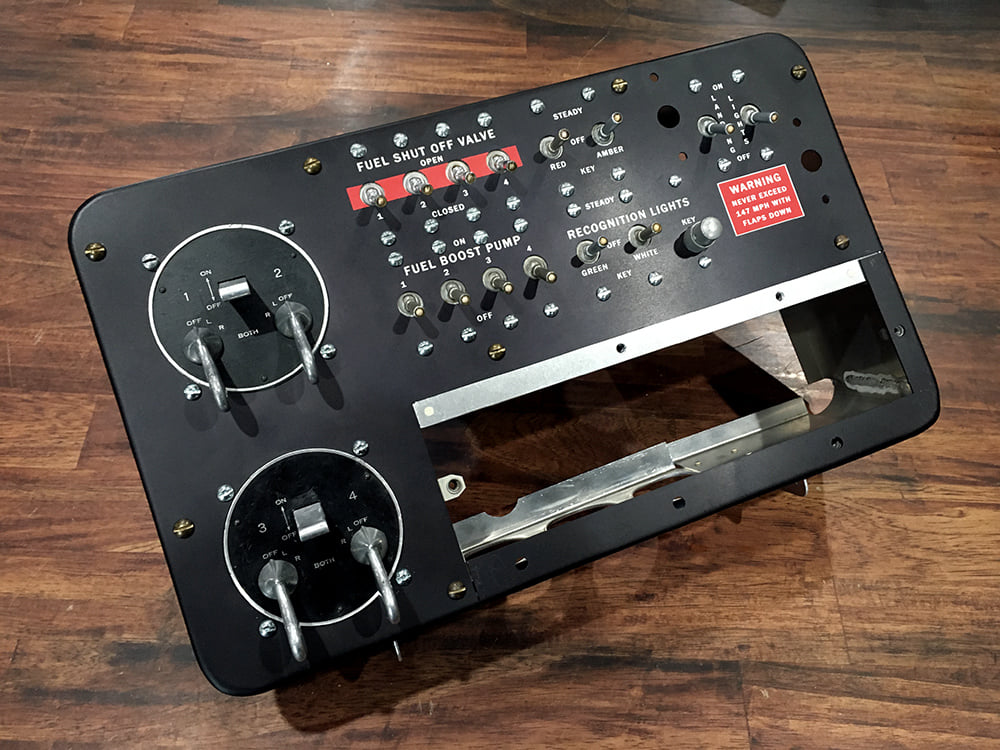
The center panel is temporarily mounted to the center console assembly.
The hole is for the hydraulic cowl flap panel.
The mounting screws are placeholders.
Photo taken 15 February 2022.
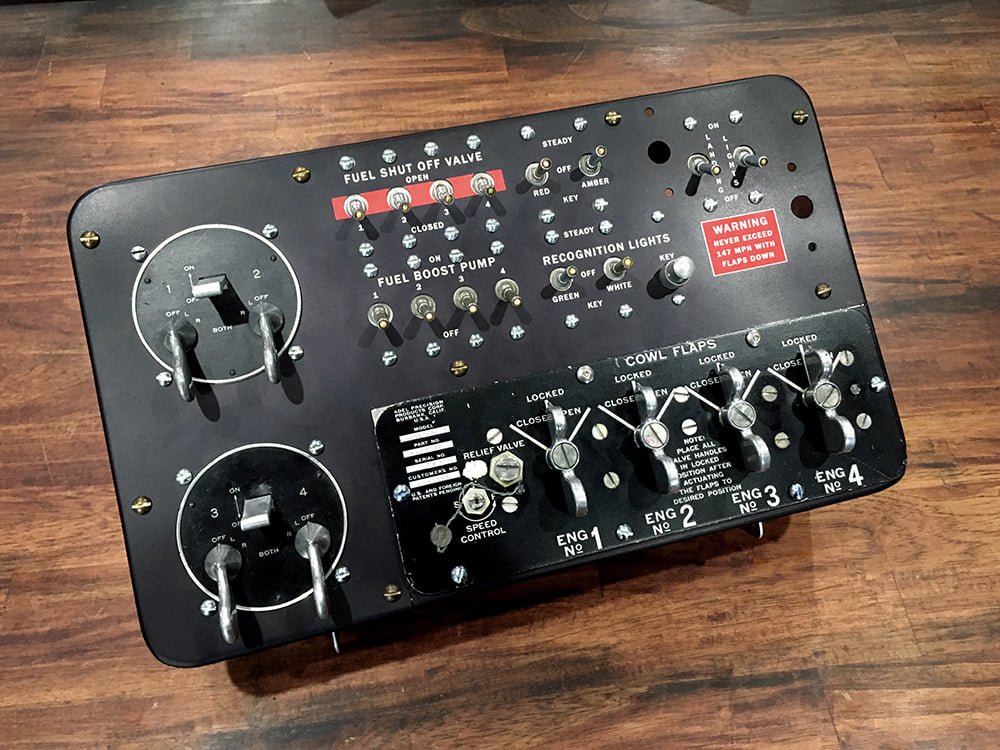
The center panel is temporarily mounted to the center console assembly. Likewise, the cowl flaps panel is temporarily mounted.
The mounting screws are placeholders.
Photo taken 15 February 2022.
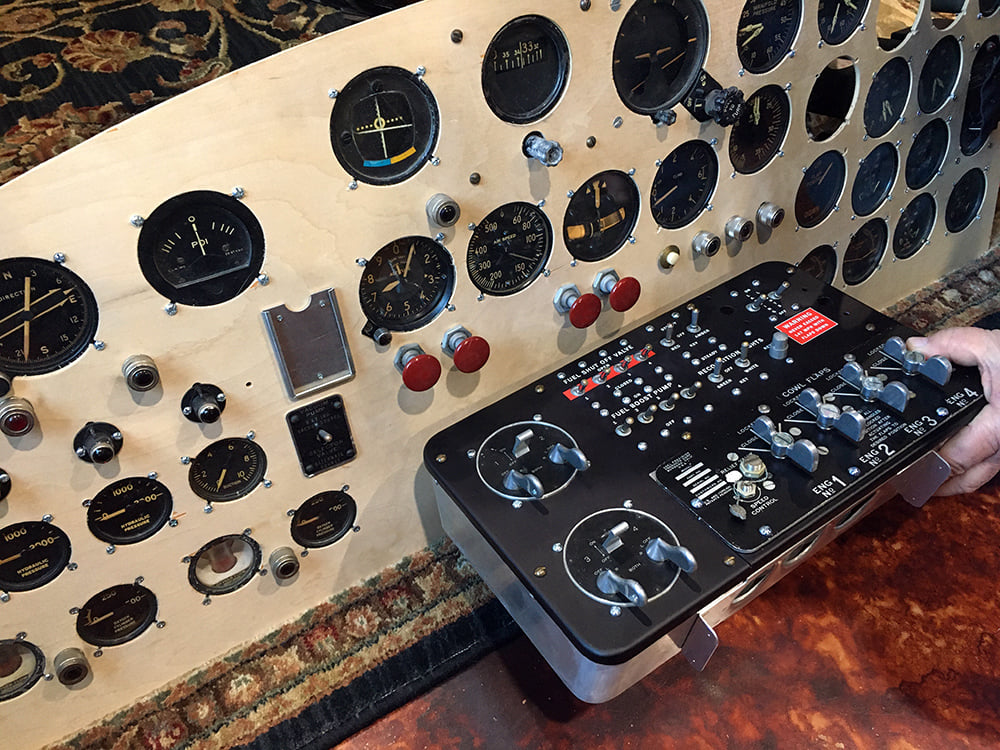
Could not help myself…
The center console assembly is held against the instrument panel mockup.
The Blind Landing Indicator on the top left will not be installed in the finished panel – Lucky Thirteen was not equipped with any blind-landing equipment during the war.
Photo taken 15 February 2022.
